Problem 1 50 points Tempe is considering replacing its fleet
Problem 1 (50 points) Tempe is considering replacing its fleet of gasoline powered cars wi th electric cars. The manufacturer of the electric cars claims a significant cost savings over the life of the fleet if Tempe chooses to pursue the conversi If the manufacturer is correct, the city will save about $1.5 on. However, some critics argue that the technology is faulty and will result significantly higher costs in -estimated at a loss of S700,000 over the life of pared to gasoline-powered cars. A third possibility, suggested by independent analysis of an the fleet com engineering firm last year is that the conversion will breakeven A consultant hired by the city to assess the conversion program estimates the probabilities of the three outcomes savings, loss, breakeven at 30%, 30% 40%, respectively. The city has the opportunity to implement a pilot program that involves renting a small number of electric cars for three months and running them under typical conditions. This program would cost the city $75,000. The city\'s consultant believes the pilot program results will be useful for estimating the value of the conve but not conclusive. She has prepared the following table of probabilities b on the experience of other cities after 3- months of usage. For example, given that a conversion actually results in savings of $1.5 million, the conditional saves money, loses money, and breaks even are 60%, 10% probabilities that the pilot will indicate that the city 30%, respectively. Actual outcome over the life of the fleet Indication of outcome from Savin Loss Breakeven ot program Indicates savings 60% 40% Indicatesloss 10% 40% 20% Indicatesbreakeren 30% 50% 40% uestions wishes to use expected payoff as the criterion for decision m a. Assuming the city use PrecisionTree to the optimal strategy construct and solve a neatly labeled decision tree for Tempe\'s decision em. Express erbally and state the corresponding optimal expected payoff (25 points) the sensitivity of your recommendation from part (a) to errors b. Assess in some of the inputs. The inputs with the greatest uncertainty in their values are the dollar loss and the savings and loss probabilities. The loss estimate could be as much as 50% worse and no more than 10% better (e.g., payoff as low as $1.05 savings probability could 50 and as high as S630,000). The be as much as lower and no more than 10% higher (e.g., as low as 15% and as high as 33%, the loss probability could be as much as 10% lower and no more than 50% higher. U se the appropriate sensitivity tool in PrecisionTree to identify when and if your optimal strategy changes as these in are varied (you may use 7 steps, i.e., 7 values ofa r as it ranges from high to low) Express the results of your sensitivity analysis verbally, identifying regions of parameter values where the optimal strategy may change from your recommendation in part (a) (15 points) Does your recommended strategy from part (a) change if the city is risk averse with a risk tolerance ion (with an exponential utility function)? Express the optimal strategy verbally and state th of sponding optimal expected payoff and the certainty equivalent (5 points) What is the expected value ofinfo assumptions of part (c? Justify your answer using results generated by PrecisionTree (i.e explain how you arrived at your answer from information in your decision tree) (5 points) 
Solution
a)
save
1,500,000*0.60 + 700,000*0.10 + 75,000*0.40 = 1,000,000
loss
1500000*0.10 + 700,000*0.40 + 75,000*0.20 =445,000
breakeven
1500000*0.30 + 700,000*0.50 + 75,000*0.40 = 830,000
optimal strategy will be saving from the pilot program because it can be generates more benefits
I can gladly help you with all your question. but you should post it in a new question.

 Homework Sourse
Homework Sourse